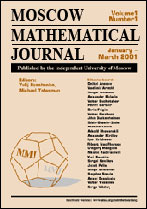|
This article is cited in 12 scientific papers (total in 12 papers)
Adelic approach to the zeta function of arithmetic schemes in dimension two
I. B. Fesenko
University of Nottingham
Abstract:
This paper suggests a new approach to the study of the fundamental properties of the zeta function of a model of elliptic curve over a global field. This complex valued commutative approach is a two-dimensional extension of the classical adelic analysis of Tate and Iwasawa. We explain how using structures which come naturally from the explicit two-dimensional class field theory and working with a new $\mathbb R((X))$-valued translation invariant measure, integration theory and harmonic analysis on various complete objects associated to arithmetic surfaces one can define and study zeta integrals which are closely related to the zeta function of a regular model of elliptic curve over global fields. In the two-dimensional adelic analysis the study of poles of the zeta function is reduced to the study of poles of a boundary term which is an integral of a certain arithmetic function over the boundary of an adelic space. The structure of the boundary and function determines the analytic properties of the boundary term and location of the poles of the zeta function, which results in applications of the theory to several key directions of arithmetic of elliptic curves over global fields.
Key words and phrases:
Elliptic curves over global fields, arithmetic surfaces, zeta function, zeta integral, two-dimensional adelic spaces, harmonic analysis, Hasse zeta functions, analytic duality, boundary term, meromorphic continuation and functional equation, mean-periodic functions, Laplace–Carleman transform, generalized Riemann hypothesis, Birch and Swinnerton–Dyer conjecture, automorphic representations.
Citation:
I. B. Fesenko, “Adelic approach to the zeta function of arithmetic schemes in dimension two”, Mosc. Math. J., 8:2 (2008), 273–317
Linking options:
https://www.mathnet.ru/eng/mmj313 https://www.mathnet.ru/eng/mmj/v8/i2/p273
|

|




 Contact us:
Contact us: Terms of Use
Terms of Use
 Registration to the website
Registration to the website Logotypes
Logotypes








 Citation in format
Citation in format 
